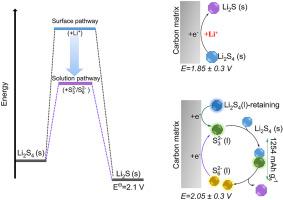Nano Energy ( IF 16.8 ) Pub Date : 2020-06-30 , DOI: 10.1016/j.nanoen.2020.105041 Hui Wang , Yuyan Shao , Huilin Pan , Xuefei Feng , Ying Chen , Yi-Sheng Liu , Eric D. Walter , Mark H. Engelhard , Kee Sung Han , Tao Deng , Guoxi Ren , Dongping Lu , Xiaochuan Lu , Wu Xu , Chunsheng Wang , Jun Feng , Karl T. Mueller , Jinghua Guo , Kevin R. Zavadil , Ji-Guang Zhang

|
Lithium-sulfur (Li–S) battery is one of the most promising candidates for the next generation energy storage systems. However, several barriers, including polysulfide shuttle effect, the slow solid-solid surface reaction pathway in the lower discharge plateau, and corrosion of Li anode still limit its practical applications, especially under the lean electrolyte condition required for high energy density. Here, we propose a solution-mediated sulfur reduction pathway to improve the capacity and reversibility of the sulfur cathode. With this method, a high coulombic efficiency (99%) and stable cycle life over 100 cycles were achieved under application-relevant conditions (S loading: 6.2 mg cm−2; electrolyte to sulfur ratio: 3 mLE gs−1; sulfur weight ratio: 72 wt%). This result is enabled by a specially designed Li2S4-rich electrolyte, in which Li2S is formed through a chemical disproportionation reaction instead of electrochemical routes. A diglyme solvent was used to obtain electrolytes with the optimum range of Li2S4 concentration. Operando X-ray absorption spectroscopy confirms the solution pathway in a practical Li–S cell. This solution pathway not only introduces a new electrolyte regime for practical Li–S batteries, but also provides a new perspective for bypassing the inefficient surface pathway for other electrochemical processes.
中文翻译:

具有在稀电解质条件下运行的溶液介导途径的锂硫电池
锂硫(Li–S)电池是下一代储能系统最有希望的候选者之一。但是,包括多硫化物的穿梭效应,下部放电平台中缓慢的固-固表面反应路径以及锂阳极的腐蚀在内的一些障碍仍然限制了其实际应用,尤其是在高能量密度所需的稀薄电解质条件下。在这里,我们提出了一种溶液介导的硫还原途径,以提高硫阴极的容量和可逆性。使用此方法,在与应用相关的条件下(S负载:6.2 mg cm -2;电解质与硫之比:3 mL E g s -1)可实现高库仑效率(99%)和超过100个循环的稳定循环寿命; 硫重量比:72重量%。通过特殊设计的富含Li 2 S 4的电解质可以实现该结果,其中Li 2 S是通过化学歧化反应而不是电化学途径形成的。使用二甘醇二甲醚溶剂获得具有最佳Li 2 S 4浓度范围的电解质。Operando X射线吸收光谱法证实了实用的Li–S电池中的溶液路径。该解决方案途径不仅为实用的Li-S电池引入了新的电解质体系,而且还为绕开其他电化学过程中无效的表面途径提供了新的视角。











































 京公网安备 11010802027423号
京公网安备 11010802027423号